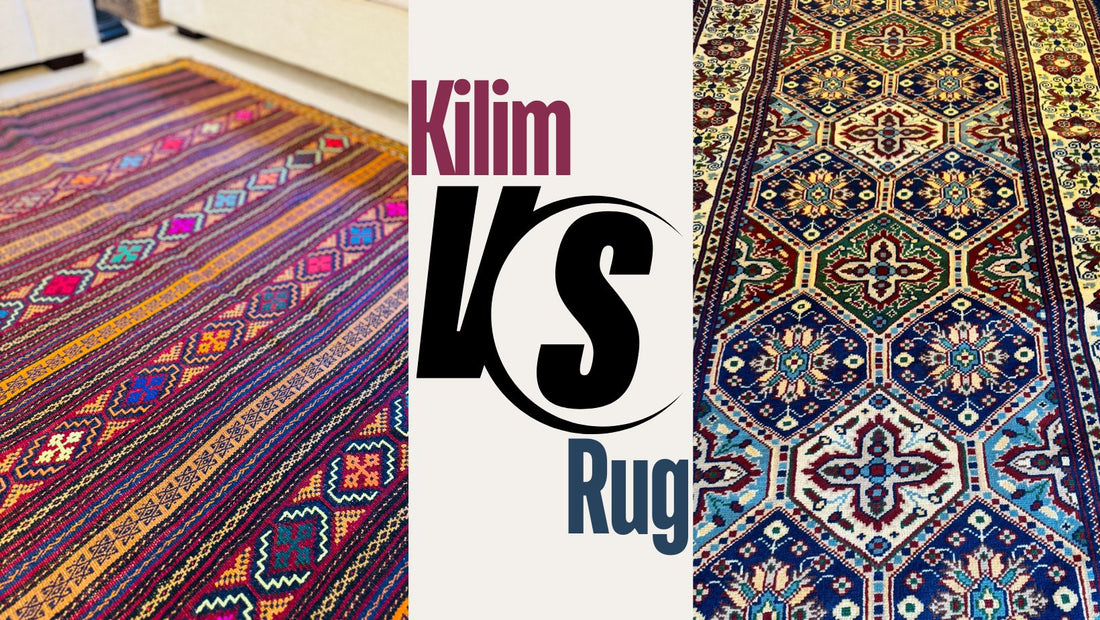Afghan rugs are treasured worldwide for their craftsmanship, artistry, and cultural significance. Among the most common types of these rugs are Kilims and hand-knotted rugs. Though both are crafted by skilled Afghan artisans, they differ in their weaving techniques, appearance, durability, and applications.
Whether you’re a first-time buyer or a seasoned rug collector, understanding these differences can help you choose the perfect rug for your space. Let’s dive into the world of Kilims and hand-knotted rugs to uncover what makes each of them unique.
What is a Kilim?
A Kilim is a type of flat-woven rug that has no pile, making it thinner and lighter than traditional hand-knotted rugs. The term “Kilim” comes from the Farsi word gelīm.
Kilims have been woven for centuries by nomadic tribes in Central Asia, particularly in Afghanistan. These versatile textiles served various purposes beyond floor coverings, including wall hangings, saddle bags, and tent decorations. The designs of Kilims often reflect the weaver's tribal identity, with patterns passed down through generations.
Weaving Technique
Kilims are made using a flat-weaving technique where the warp (vertical threads) and weft (horizontal threads) are tightly interwoven. This process creates a smooth, reversible surface with no pile. Weavers often use a technique called slit-weave to create sharp, geometric patterns by leaving small gaps between color changes.
Characteristics
- Pile: No pile; flat surface.
- Texture: Lightweight and flexible.
- Patterns: Typically geometric with bold, vibrant colors.
- Reversible: Both sides are often identical, allowing for reversible use.
Materials
Kilims are traditionally made from wool, though some variations incorporate cotton or goat hair. Natural dyes derived from plants and minerals give Kilims their rich, earthy tones.
What is a Hand-Knotted Rug?
A hand-knotted rug is a type of rug crafted by tying individual knots onto a warp and weft foundation, creating a plush, textured pile. These rugs are renowned for their intricate designs and exceptional durability. Hand-knotted rugs have a long and storied history in Afghanistan, where each region and tribe has developed its own distinct style. These rugs often feature detailed patterns, including floral, geometric, and curvilinear motifs.
Weaving Technique
In hand-knotted rug weaving, artisans meticulously tie thousands of knots onto a vertical loom. Each knot forms part of the rug's pile, contributing to its thickness and texture. The density of the knots (knots per square inch) often indicates the rug’s quality and level of detail. Common knot types include the Persian knot (asymmetrical) and the Turkish knot (symmetrical).
Characteristics
- Pile: Thick, plush pile.
- Texture: Dense and luxurious.
- Patterns: Intricate designs, including floral motifs and detailed borders.
- Durability: Highly durable and long-lasting.
Materials
Hand-knotted rugs are typically made from wool, silk, or cotton. High-quality wool provides durability, while silk adds a sheen and softness to more luxurious pieces.
Key Differences Between Kilims and Hand-Knotted Rugs
Now that we understand Kilims and hand-knotted rugs individually, let's explore the key differences between the two:
-
Weaving Technique
- Kilims: Made using a flat-weaving technique where threads are interwoven tightly.
- Hand-Knotted Rugs: Made by tying individual knots onto a foundation to create a pile.
-
Appearance
- Kilims: Flat, lightweight, with bold geometric patterns.
- Hand-Knotted Rugs: Plush, textured surface with intricate and detailed designs.
-
Durability
- Kilims: Durable for lighter use but may wear faster in high-traffic areas.
- Hand-Knotted Rugs: Extremely durable and can last for generations with proper care.
-
Cost
- Kilims: Generally more affordable due to simpler weaving techniques.
- Hand-Knotted Rugs: Higher cost because of the labor-intensive knotting process.
-
Maintenance
- Kilims: Easier to clean, often reversible.
- Hand-Knotted Rugs: Require more careful maintenance and occasional professional cleaning.
-
Use Cases
- Kilims: Ideal for casual spaces, wall hangings, or layering over other rugs.
- Hand-Knotted Rugs: Perfect for formal living spaces, heirloom collections, or high-traffic areas.
Pros and Cons of Kilims
Pros:
- Lightweight and Portable: Easy to move and store.
- Affordable: Budget-friendly compared to hand-knotted rugs.
- Versatile: Can be used as floor coverings, wall hangings, or decorative throws.
- Reversible: Both sides can be used, increasing longevity.
Cons:
- Less Durable: Not ideal for high-traffic areas.
- Limited Design Complexity: Geometric patterns dominate, with less intricate detailing.
- Prone to Slippage: May need a rug pad to stay in place.
Pros and Cons of Hand-Knotted Rugs
Pros:
- Extremely Durable: Can last for generations with proper care.
- Intricate Designs: Offers detailed and elaborate patterns.
- Heirloom Quality: A worthwhile investment that increases in value over time.
- Luxurious Feel: The plush pile adds warmth and comfort.
Cons:
- Higher Cost: More expensive due to labor-intensive production.
- Heavy: Not as easy to transport or store.
- Maintenance Needs: Requires professional cleaning for deep stains or wear.
Choosing Between a Kilim and a Hand-Knotted Rug
When deciding between a Kilim and a hand-knotted rug, consider these factors:
-
Your Space:
- Kilims: Perfect for casual or bohemian decor, kitchens, or as wall hangings.
- Hand-Knotted Rugs: Best for formal spaces, living rooms, and areas where luxury and durability are important.
-
Budget:
- Kilims: More affordable for those seeking beautiful decor on a budget.
- Hand-Knotted Rugs: Worth the investment for their longevity and artistry.
-
Lifestyle:
- Kilims: Ideal if you prefer lightweight, easy-to-clean rugs.
- Hand-Knotted Rugs: Perfect for families wanting a durable heirloom piece.
Conclusion
Both Kilims and hand-knotted rugs represent the incredible artistry and heritage of Afghan rug weaving. While Kilims offer versatility, affordability, and bold geometric patterns, hand-knotted rugs provide luxury, intricate designs, and exceptional durability.
Understanding the differences between these two types of rugs allows you to choose the perfect piece for your space, lifestyle, and budget. Whether you’re decorating a cozy corner with a colorful Kilim or anchoring your living room with a timeless hand-knotted rug, each type brings warmth, beauty, and culture to your home.
Looking for the perfect Afghan rug to elevate your home?
Explore our curated collection of authentic Kilims and hand-knotted rugs at Rugnify.com. Every rug tells a story of tradition, craftsmanship, and Afghan heritage. Find the one that speaks to you today!
Stay connected and subscribe to our blog for more rug insights, styling tips, and behind-the-scenes stories from the world of Afghan artisans.




